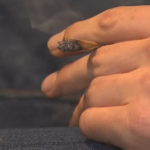Reducing the amount of agricultural sprays used by farmers—including fertilizers, pesticides, and herbicides—could cut down the amount of polluting runoff that ends up in the environment while at the same time reducing farmers’ costs and perhaps even enhancing their productivity. A classic win-win-win.
A team of researchers at MIT and a spinoff company they launched has developed a system to do just that. Their technology adds a thin coating around droplets as they are being sprayed onto a field, greatly reducing their tendency to bounce off leaves and end up wasted on the ground. Instead, the coated droplets stick to the leaves as intended.
The research is described today in the journal Soft Matter, in a paper by recent MIT alumni Vishnu Jayaprakash Ph.D. ’22 and Sreedath Panat Ph.D. ’23, graduate student Simon Rufer, and MIT professor of mechanical engineering Kripa Varanasi.
A recent study found that if farmers didn’t use pesticides, they would lose 78% of fruit, 54% of vegetable, and 32% of cereal production. Despite their importance, a lack of technology that monitors and optimizes sprays has forced farmers to rely on personal experience and rules of thumb to decide how to apply these chemicals. As a result, these chemicals tend to be over-sprayed, leading to runoff and chemicals ending up in waterways or building up in the soil.
Pesticides take a significant toll on global health and the environment, the researchers point out. A recent study found that 31% of agricultural soils around the world were at high risk from pesticide pollution. And agricultural chemicals are a major expense for farmers: In the U.S., they spend $16 billion a year just on pesticides.
Making spraying more efficient is one of the best ways to make food production more sustainable and economical. Agricultural spraying essentially boils down to mixing chemicals into water and spraying water droplets onto plant leaves, which are often inherently water-repellent. “Over more than a decade of research in my lab at MIT, we have developed fundamental understandings of spraying and the interaction between droplets and plants—studying when they bounce and all the ways we have to make them stick better and enhance coverage,” Varanasi says.
The team had previously found a way to reduce the amount of sprayed liquid that bounces away from the leaves it strikes, which involved using two spray nozzles instead of one and spraying mixtures with opposite electrical charges. But they found that farmers were reluctant to take on the expense and effort of converting their spraying equipment to a two-nozzle system. So, the team looked for a simpler alternative.
They discovered they could achieve the same improvement in droplet retention using a single-nozzle system that can be easily adapted to existing sprayers. Instead of giving the droplets of pesticide an electric charge, they coat each droplet with a vanishingly thin layer of an oily material.
In their new study, they conducted lab experiments with high-speed cameras. When they sprayed droplets with no special treatment onto a water-repelling (hydrophobic) surface similar to that of many plant leaves, the droplets initially spread out into a pancake-like disk, then rebounded back into a ball and bounced away. But when the researchers coated the surface of the droplets with a tiny amount of oil—making up less than 1% of the droplet’s liquid—the droplets spread out and then stayed put. The treatment improved the droplets’ “stickiness” by as much as a hundredfold.
“When these droplets are hitting the surface and as they expand, they form this oil ring that essentially pins the droplet to the surface,” Rufer says. The researchers tried a wide variety of conditions, he says, explaining that they conducted hundreds of experiments, “with different impact velocities, different droplet sizes, different angles of inclination, all the things that fully characterize this phenomenon.”
Though different oils varied in their effectiveness, all of them were effective. “Regardless of the impact velocity and the oils, we saw that the rebound height was significantly lower,” he says.
The effect works with remarkably small amounts of oil. In their initial tests they used 1% oil compared to the water, then they tried a 0.1%, and even .01%. The improvement in droplets sticking to the surface continued at a 0.1%, but began to break down beyond that. “Basically, this oil film acts as a way to trap that droplet on the surface, because oil is very attracted to the surface and sort of holds the water in place,” Rufer says.
In the researchers’ initial tests they used soybean oil for the coating, figuring this would be a familiar material for the farmers they were working with, many of whom were growing soybeans. But it turned out that though they were producing the beans, the oil was not part of their usual supply chain for use on the farm. In further tests, the researchers found that several chemicals that farmers were already routinely using in their spraying, called surfactants and adjuvants, could be used instead, and that some of these provided the same benefits in keeping the droplets stuck on the leaves.
“That way,” Varanasi says, “we’re not introducing a new chemical or changed chemistries into their field, but they’re using things they’ve known for a long time.”
Varanasi and Jayaprakash formed a company called AgZen to commercialize the system. In order to prove how much their coating system improves the amount of spray that stays on the plant, they first had to develop a system to monitor spraying in real time.
That system, which they call RealCoverage, has been deployed on farms ranging in size from a few dozen acres to hundreds of thousands of acres, and many different crop types, and has saved farmers 30 to 50% on their pesticide expenditures, just by improving the controls on the existing sprays.
The system is being deployed to 920,000 acres of crops in 2025, the company says, including some in California, Texas, the Midwest, France, and Italy. Adding the cloaking system using new nozzles, the researchers say, should yield at least another doubling of efficiency.
“You could give back a billion dollars to U.S. growers if you just saved 6% of their pesticide budget,” says Jayaprakash, lead author of the research paper and CEO of AgZen. “In the lab we got 300% of extra product on the plant. So that means we could get orders of magnitude reductions in the amount of pesticides that farmers are spraying.”
Farmers had already been using these surfactant and adjuvant chemicals as a way to enhance spraying effectiveness, but they were mixing it with a water solution. For it to have any effect, they had to use much more of these materials, risking causing burns to the plants. The new coating system reduces the amount of these materials needed, while improving their effectiveness.
In field tests conducted by AgZen, “we doubled the amount of product on kale and soybeans just by changing where the adjuvant was,” from mixed in to being a coating, Jayaprakash says. It’s convenient for farmers because “all they’re doing is changing their nozzle. They’re getting all their existing chemicals to work better, and they’re getting more product on the plant.”
And it’s not just for pesticides. “The really cool thing is this is useful for every chemistry that’s going on the leaf, be it an insecticide, a herbicide, a fungicide, or foliar nutrition,” Varanasi says. This year, they plan to introduce the new spray system on about 30,000 acres of cropland.
Varanasi says that with projected world population growth, “the amount of food production has got to double, and we are limited in so many resources, for example, we cannot double the arable land. … This means that every acre we currently farm must become more efficient and able to do more with less.” These improved spraying technologies, for both monitoring the spraying and coating the droplets, Varanasi says, “I think is fundamentally changing agriculture.”
AgZen has recently raised $10 million in venture financing to support rapid commercial deployment of these technologies that can improve the control of chemical inputs into agriculture.
“The knowledge we are gathering from every leaf, combined with our expertise in interfacial science and fluid mechanics, is giving us unparalleled insights into how chemicals are used and developed—and it’s clear that we can deliver value across the entire agrochemical supply chain,” Varanasi says.
“Our mission is to use these technologies to deliver improved outcomes and reduced costs for the ag industry.”
More information:
Vishnu Jayaprakash et al, Enhancing spray retention using cloaked droplets to reduce pesticide pollution, Soft Matter (2025). DOI: 10.1039/D4SM01496K pubs.rsc.org/en/content/articl … g/2025/sm/d4sm01496k
Provided by
Massachusetts Institute of Technology
This story is republished courtesy of MIT News (web.mit.edu/newsoffice/), a popular site that covers news about MIT research, innovation and teaching.
Citation:
New spray technology helps pesticides stick to plant leaves to reduce polluting runoff (2025, March 25)
retrieved 26 March 2025
from https://phys.org/news/2025-03-spray-technology-pesticides-polluting-runoff.html
This document is subject to copyright. Apart from any fair dealing for the purpose of private study or research, no
part may be reproduced without the written permission. The content is provided for information purposes only.











